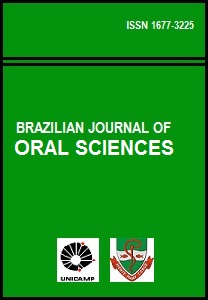Abstract
Aim: The aim of this study was to evaluate the fracture resistance of human premolars with extensive cavity preparations of the inlay and onlay types, for performing direct and indirect composite resin restorations. Methods: Eight-four premolars were divided into 7 groups (n=12): G1=intact teeth; G2=inlay/Filtek Z-250 direct; G3=inlay/ Filtek Z-250 light polymerized indirectly; G4=inlay/ Solidex; G5=onlay/ Filtek Z-250 direct; G6=onlay/ Filtek Z-250 light polymerized indirectly; G7=onlay/ Solidex. Indirect Filtek Z- 250 restorations were light activated using the EDG-lux oven. All samples were submitted to axial compression load in a Universal Testing Machine until fracture. The data were submitted to the one-way ANOVA and Tukey’s test (a=0.05). Results: The results (N) were: G6-1938a, G5-1570ab, G7-1285b, G1-1215b, G4-1174b, G3-1146b and G2-1112b. The onlay cavities restored indirectly with Filtek Z-250 presented significantly higher fracture resistance (G6) than the other groups, except for onlay restorations made directly with Filtek Z-250 (G5), which, in turn, did not differ significantly from the other groups. However, the onlay restorations made with Filtek Z-250 led to more catastrophic failure modes. Conclusions: 1. Adhesive inlay restorations, irrespective of the type of composite resin and light-activation technique used, restored the fracture resistance of intact teeth.The Brazilian Journal of Oral Sciences uses the Creative Commons license (CC), thus preserving the integrity of the articles in an open access environment.
Downloads
Download data is not yet available.

